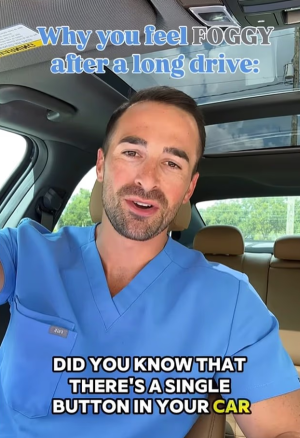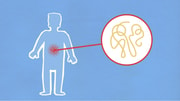Shocking Reason Your Daily Car Habit Could Be Slowing Down Your Brain, According to a Doctor
By
Gian T
- Replies 0
We all have our little car rituals—maybe it’s tuning the radio to your favourite station, adjusting the seat just so, or flicking on the air con as soon as you hop in. But did you know that one innocent-looking button on your dashboard could be quietly sabotaging your brain every time you drive?
That’s right, members! Dr Clay Moss, a US-based doctor, has sent shockwaves through the motoring world with a viral video that’s racked up nearly 7 million views. His warning? The humble recirculation button—the one with the little arrow looping in a car shape—might be doing more harm than good if you leave it on for too long.
What’s the Recirculation Button, Anyway?
If you’re not sure what we’re talking about, the recirculation button is usually found near your air conditioning controls. When you press it, your car stops drawing in fresh air from outside and instead keeps circulating the air already inside the cabin. It’s a godsend on a hot day when you want to cool down quickly, or when you’re driving through a cloud of dust or behind a smoky truck.
But here’s the catch: while it’s great for keeping out unpleasant smells and cooling things down fast, using it for extended periods can have some surprising side effects.
The Hidden Danger: Carbon Dioxide Buildup
Dr Moss explains that when your car is sealed up tight and recirculating air, carbon dioxide (CO2) from your breath starts to build up. In as little as 30 minutes, CO2 levels can climb to over 1,200 parts per million (ppm)—and with a couple of passengers, it can easily hit 2,500–3,000ppm. That’s well above the threshold where your brain starts to slow down, making you drowsy, foggy, and irritable.
And it’s not just theory—studies have shown that even solo drivers can reach these levels on longer trips, especially if the recirculation mode is left on the whole time. For those of us who enjoy a good road trip or have a long commute, this is definitely something to keep in mind!
How Does High CO2 Affect You?
You might be wondering, 'So what if there’s a bit more CO2?' Well, elevated CO2 levels can have a real impact on your cognitive function. According to Dr Moss, you might notice:
- Slower reaction times (not ideal when you’re behind the wheel!)
- Trouble concentrating or staying alert
- Feeling drowsy or even nodding off
- Increased irritability or ‘road rage’
In other words, your brain just isn’t firing on all cylinders—hardly what you want when you’re navigating busy roads or unfamiliar routes.
A Simple Fix for a Safer Drive
Before you start panicking and swearing off the recirculation button forever, there’s good news. Dr Moss says the solution is quick and easy: just crack a window or switch your air con to ‘fresh air’ mode for a couple of minutes every half hour or so. This simple step flushes out the built-up CO2 and brings in a fresh supply of oxygen, keeping your mind sharp and your reflexes quick.
And if you drive a newer car, you might be in luck—many modern vehicles have automatic recirculation timers that switch the system back to fresh air after a set period, helping to keep you safe without you even realising it.
Why Do We Use Recirculation Mode So Much?
Many of us use recirculation mode to block out city smog, dust, or unpleasant odours, especially if you’re driving through roadworks or behind a smoky old ute. Others use it to cool the car down quickly on a hot Aussie day. But as Dr Moss points out, it’s best to use it sparingly—just long enough to get comfortable, then switch back to fresh air.
What Do Other Drivers Say?
Dr Moss’s video has sparked a lively debate online. Some drivers admitted they’d never thought about the risks, while others wondered if their daily drowsiness or road rage could be linked to CO2 buildup. One person even joked, 'Is that why I suffer from road rage?' Another confessed, 'I drive to work two hours each way every day… is this why I get so sleepy by the time I get to my destination?'
Credit: TikTok
 Have you ever noticed yourself getting sleepy or foggy-headed on long drives? Do you use the recirculation button often, or do you prefer a bit of fresh air? Share your experiences and tips in the comments below—we’d love to hear from you! Safe travels, members!
Have you ever noticed yourself getting sleepy or foggy-headed on long drives? Do you use the recirculation button often, or do you prefer a bit of fresh air? Share your experiences and tips in the comments below—we’d love to hear from you! Safe travels, members!
Read more: Experiencing migraines? Discover the shocking truth of what's really going on in your brain!
That’s right, members! Dr Clay Moss, a US-based doctor, has sent shockwaves through the motoring world with a viral video that’s racked up nearly 7 million views. His warning? The humble recirculation button—the one with the little arrow looping in a car shape—might be doing more harm than good if you leave it on for too long.
What’s the Recirculation Button, Anyway?
If you’re not sure what we’re talking about, the recirculation button is usually found near your air conditioning controls. When you press it, your car stops drawing in fresh air from outside and instead keeps circulating the air already inside the cabin. It’s a godsend on a hot day when you want to cool down quickly, or when you’re driving through a cloud of dust or behind a smoky truck.
But here’s the catch: while it’s great for keeping out unpleasant smells and cooling things down fast, using it for extended periods can have some surprising side effects.
The Hidden Danger: Carbon Dioxide Buildup
Dr Moss explains that when your car is sealed up tight and recirculating air, carbon dioxide (CO2) from your breath starts to build up. In as little as 30 minutes, CO2 levels can climb to over 1,200 parts per million (ppm)—and with a couple of passengers, it can easily hit 2,500–3,000ppm. That’s well above the threshold where your brain starts to slow down, making you drowsy, foggy, and irritable.
And it’s not just theory—studies have shown that even solo drivers can reach these levels on longer trips, especially if the recirculation mode is left on the whole time. For those of us who enjoy a good road trip or have a long commute, this is definitely something to keep in mind!
How Does High CO2 Affect You?
You might be wondering, 'So what if there’s a bit more CO2?' Well, elevated CO2 levels can have a real impact on your cognitive function. According to Dr Moss, you might notice:
- Slower reaction times (not ideal when you’re behind the wheel!)
- Trouble concentrating or staying alert
- Feeling drowsy or even nodding off
- Increased irritability or ‘road rage’
In other words, your brain just isn’t firing on all cylinders—hardly what you want when you’re navigating busy roads or unfamiliar routes.
A Simple Fix for a Safer Drive
Before you start panicking and swearing off the recirculation button forever, there’s good news. Dr Moss says the solution is quick and easy: just crack a window or switch your air con to ‘fresh air’ mode for a couple of minutes every half hour or so. This simple step flushes out the built-up CO2 and brings in a fresh supply of oxygen, keeping your mind sharp and your reflexes quick.
And if you drive a newer car, you might be in luck—many modern vehicles have automatic recirculation timers that switch the system back to fresh air after a set period, helping to keep you safe without you even realising it.
Why Do We Use Recirculation Mode So Much?
Many of us use recirculation mode to block out city smog, dust, or unpleasant odours, especially if you’re driving through roadworks or behind a smoky old ute. Others use it to cool the car down quickly on a hot Aussie day. But as Dr Moss points out, it’s best to use it sparingly—just long enough to get comfortable, then switch back to fresh air.
What Do Other Drivers Say?
Dr Moss’s video has sparked a lively debate online. Some drivers admitted they’d never thought about the risks, while others wondered if their daily drowsiness or road rage could be linked to CO2 buildup. One person even joked, 'Is that why I suffer from road rage?' Another confessed, 'I drive to work two hours each way every day… is this why I get so sleepy by the time I get to my destination?'
Credit: TikTok
Key Takeaways
- A doctor has warned that using the recirculation button in your car for too long can cause a dangerous build-up of carbon dioxide, which can slow your brain down and make you drowsy and irritable.
- Research shows that even after just 30 minutes in recirculation mode, CO2 levels in your car can exceed safe limits, especially if there are two or more people in the vehicle.
- The problem can easily be fixed by cracking a window or switching your climate control to fresh air mode for a couple of minutes to flush out the CO2 and keep your brain sharp.
- Many drivers were shocked to learn about the risks, with some saying they use the recirculation mode constantly to avoid city smog, not realising it could be messing with their cognition.
Read more: Experiencing migraines? Discover the shocking truth of what's really going on in your brain!








